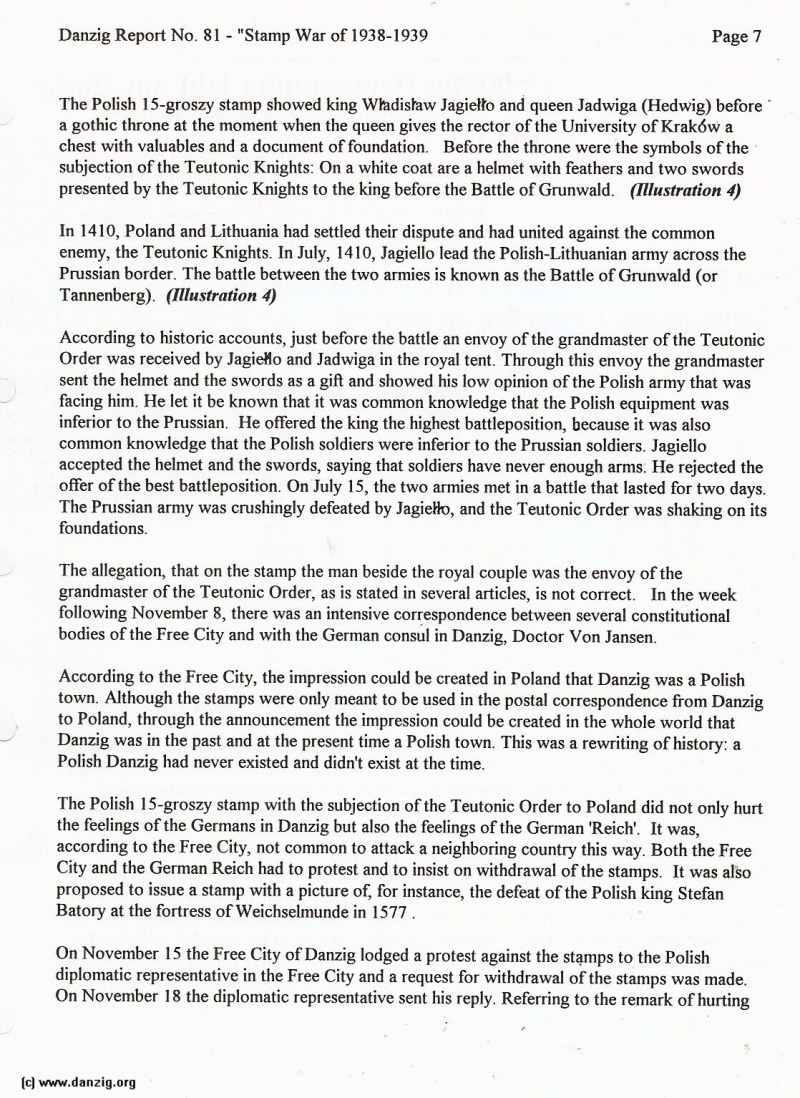
The Polish I 5-groszy stamp showed king W1disaw Jagielto and queen Jadwiga (Hedwig) before a gothic throne at the moment when the queen gives the rector of the University of Kraków a chest with valuables and a document of foundation. Before the throne were the symbols of the subjection of the Teutonic Knights: On a white coat are a helmet with feathers and two swords presented by the Teutonic Knights to the king before the Battle of Grunwald. (illustration 4)
In 1410, Poland and Lithuania had settled their dispute and had united against the common enemy, the Teutonic Knights. In July, 1410, Jagiello lead the Polish-Lithuanian army across the Prussian border. The battle between the two armies is known as the Battle of Grunwald (or Tannenberg). (Illustration 4)
According to historic accounts, just before the battle an envoy of the grandmaster of the Teutonic Order was received by Jagielio and Jadwiga in the royal tent. Through this envoy the grandmaster sent the helmet and the swords as a gift and showed his low opinion of the Polish army that was facing him. He let it be known that it was common knowledge that the Polish equipment was inferior to the Prussian. He offered the king the highest battleposition, because it was also common knowledge that the Polish soldiers were inferior to the Prussian soldiers. Jagiello accepted the helmet and the swords, saying that soldiers have never enough arms. He rejected the offer of the best battleposition. On July 15, the two armies met in a battle that lasted for two days. The Prussian army was crushingly defeated by Jagiello, and the Teutonic Order was shaking on its foundations.
The allegation, that on the stamp the man beside the royal couple was the envoy of the grandmaster of the Teutonic Order, as is stated in several articles, is not correct. In the week following November 8, there was an intensive correspondence between several constitutional bodies of the Free City and with the German consul in Danzig, Doctor Von Jansen.
According to the Free City, the impression could be created in Poland that Danzig was a Polish town. Although the stamps were only meant to be used in the postal correspondence from Danzig to Poland, through the announcement the impression could be created in the whole world that Danzig was in the past and at the present time a Polish town. This was a rewriting of history: a Polish Danzig had never existed and didn’t exist at the time.
The Polish 15-groszy stamp with the subjection of the Teutonic Order to Poland did not only hurt the feelings of the Germans in Danzig but also the feelings of the German ‘Reich’. It was, according to the Free City, not common to attack a neighboring country this way. Both the Free City and the German Reich had to protest and to insist on withdrawal of the stamps. It was also proposed to issue a stamp with a picture of, for instance, the defeat of the Polish king Stefan Batory at the fortress of Weichselmunde in 1577.
On November 15 the Free City of Danzig lodged a protest against the stamps to the Polish diplomatic representative in the Free City and a request for withdrawal of the stamps was made. On November 18 the diplomatic representative sent his reply. Referring to the remark of hurting
Danzig Report Vol. 1 - Nr. 80 - October - November - December - 1993, Page 7.
Hits: 3675
Added: 06/07/2015
Copyright: 2025 Danzig.org

